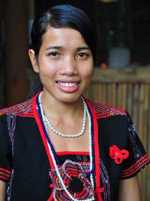Poverty reduction
How tourism makes a difference in poor areas of Viet Nam
Over the last three years, an International Labour Organization (ILO) project in Viet Nam has developed tourism-boosting jobs and reduced poverty in neglected areas.
 Dinh Thi Thin, local tour guide and deputy director of Bho Hoong's community-based tourism management board Dinh Thi Thin, local tour guide and deputy director of Bho Hoong's community-based tourism management board |
As a Co Tu – representing a minority ethnic group in Quang Nam Province – Thin first thought the two years she spent with tourism training at a college were a waste of time. In the end, she figured she would become a farmer to take care of her family.
“I was lucky to be one of the few young people from the village who was able to go to college. But at the same time I somehow accepted I would settle down, and live like the other Co Tu people who do not participate in economic life because of the lack of job opportunities here,” she said.
ILO’s influence
With almost 3,300 kilometers of coast line and 7.8 million international visitors a year, tourism has been one of the driving forces of the economy in this Southeast Asian country. The significant growth of this US$10.7 billion industry has been a major source of job creation. However, much of tourism development has been limited to a few key popular destinations along the coast, whereas those in the rural interior of the country have benefited little.Quang Nam Province, had attracted significant investment to develop tourism infrastructure along its 125 km of sandy beaches, with their unique coral reefs, and two of the world’s cultural heritage sites – My Son Sanctuary and Hoi An Old Quarters. Tourism to small inland villages, however, was largely limited to day trips from the coast, with little benefit to the more remote inland areas.
Reaching remote areas
The ILO project in Quang Nam Province tries to promote more balanced growth, using tourism as a vehicle for poverty reduction in the rural and mountainous areas.The Luxembourg-funded project is based on a sustainable approach, using the ILO Toolkit on Poverty Reduction Through Tourism. The idea is to connect poor and isolated communities with the booming tourism industry, offering villagers opportunities to sell their handicrafts, as well as providing other features for tourists.

“The tourism value chain and its significant connection to other sectors, such as agriculture, construction, utilities and transport, as shown internationally, can contribute to poverty reduction and economic development in Viet Nam. One job in the core tourism industry indirectly generates 1.5 additional jobs in the related economy,” said ILO Viet Nam Director, Gyorgy Sziraczki.
Over the last three years the project has developed a set of training materials for small and medium-sized hotels and guest houses, and a training package for tour guides and drivers. It also created linkages between tourism schools and tourism businesses in Quang Nam Province.
Only a few months after opening their doors to visitors in mid-2013 as part of the project, the three community-based tourism villages, including Bho Hoong, started to report net profits from tourism activities.
New source of income

“Tourism brought fresh air to our lives – something I would have never dreamed of before,” said Thin, now a wife and mother of a four-year-old daughter. “The ILO project provided our village with useful knowledge on community-based tourism. Now I can do what I like to and I am happy to see other villagers also opting for tourism to make their living, in addition to traditional farming.”
Thin now works as a local tour guide and has become the deputy director of the village’s community-based tourism management board, helping tour operators generate business in her community. Over the past two years, she also volunteered to teach English to other villagers.
The locals, however, were not the only ones who benefitted directly from community-based tourism in this mountainous area.
“Our guests love their experience here. They enjoy their homestay and local products provided by the villagers,” said Phan Thi Hien, manager of Active Adventure, one of the travel agencies organizing tours to Bho Hoong Village. “I’m pleased to see how it diversifies our tours and increases our revenues, while helping to improve the life of the locals.”
In addition to Quang Nam Province, the Toolkit on Poverty Reduction Through Tourism has been successfully introduced in eight other provinces by the Viet Nam Administration of Tourism.
“And we plan to extend it to other localities so that more and more Vietnamese people could benefit from new productive work opportunities in the growing tourism sector,” concluded the ILO Viet Nam Director.